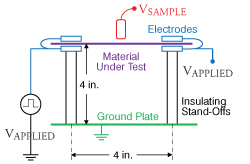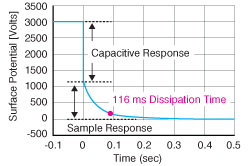Static Beat: Static Dissipation Testing
- Published: July 01, 2011, By By Dr. Kelly Robinson Contributing Editor
From packaging that protects high tech electronic devices to webs that minimize static problems during production, antistatic films are big business. Dissipating static prevents sparks that can damage electronic components or ignite flammable vapors. Plus, keeping static levels low helps prevent dust contamination problems on sensitive products.
Static dissipates to ground through electrically conductive paths, and we don't need very much conductivity. In fact, the numbers are so small that it is easier to talk about resistivity, which is the inverse of conductivity. Measuring resistivity is a great way to track product performance and to set material specifications. ASTM D-257 is the industry standard for making these important measurements.
Resistivity, while being very important, is a step away from what we need. We need to know just how fast static will dissipate. Suppose we specify that a material must have a surface resistivity less than 1E+12 Ohm/sq. Is that a good requirement? If a material meets this specification, will static be gone in one second or in one hour?

The “engineering answer” is…well…it depends. We know that the static dissipation time depends on the resistivity. However, static dissipation also depends on the geometry, like the distance to nearby conveyance rollers or to machine frame elements. So, the “practical answer” is that we must decide on a “standard geometry” so we can test films and get consistent results. Figure 1 is the standard geometry defined by MIL-STD-3010A (8/15/05) Test Method 4046 — Electrostatic Properties as amended by 3010B (3/31/08). These standards are available at www.ansi.org, the American National Standards Inst. website.
The Material Under Test (MUT) in Figure 1 is 3 in. wide and at least 5 in. long. It is held by metal electrodes attached to insulating stand-offs. Voltage applied to the electrodes charges the sample to a uniform voltage. When the applied voltage is set to zero, static dissipation is measured by monitoring the voltage at the center of the MUT using a non-contacting electrostatic voltmeter.

While the standard requires an applied voltage of ±5 kV, I must limit the applied voltage to ±3 kV because this is the upper limit of my electrostatic voltmeter. The typical response in Figure 2 has two parts. First is an immediate decrease caused by capacitive coupling between the voltmeter probe and the electrodes. The important second part is the sample response that is analyzed to find the time needed for the voltage to decrease to 10% of its initial level. The static decay time for this material is 116 ms (0.116 sec). A common requirement is for the 10% static decay time to be less than half a second (0.5 sec). So, this material would meet that requirement easily. business loan underwriter salary, business loan usa, business loan utah, business loan vs personal loan, business loan vs line of credit, business loan vs mortgage, business loan va, business loan veteran, business loan vs home loan, business loan vs home equity loan, business loan versus personal loan, business loan versus line of credit, business loan vs investors, business loan with bad credit, business loan wells fargo, business loan with collateral, business loan without personal guarantee, business loan with no credit GET THE BUSINESS FUNDING YOU NEED. BUY UNLIMITED MONEY TRANSFER FROM RUSSIAN HACKERS. INSTANT MONEY TRANSFER TO YOUR BANK ACCOUNT. OVER $10 MILLION business loan with bad personal credit, INSTANT
While resistivity is a good way to specify product requirements, measuring static dissipation time is a direct way to measure product performance. I invite you to ask questions about this column and to suggest topics for a future “Static Beat.”
Static control expert Dr. Kelly Robinson, president of Electrostatic Answers, has 27+ years of experience in problem-solving and consulting. Contact him at 585-425-8158; kelly.robinson@electrostaticanswers.com; www.electrostaticanswers.com.












